Gasification is one of the most effective methods for the production of energy and chemicals from biomass or carbon by-products as it is an extremely flexible process both in input and output.
At the input, its versatility is expressed in the fact that it can treat, and therefore manage, a multitude of raw materials, both homogeneous and mixed.
At the output, however, the versatility is expressed in the fact that the process generates syngas, made up of H2, CO and CH4, which can be used for numerous applications which are in themselves extremely different: from simple energy production to recombination to produce a chemical or to the decomposition and consequent isolation of the individual elements.
Furthermore, given the nature of the process, gasification can be carried out in total absence of emissions or generation of waste by-products.
IN order to produce urea by gasification, the gasification unit was integrated with a dry reforming reactor, to increase the hydrogen content in the output stream, and with a separation unit equipped with a palladium membrane for the separation of the hydrogen. Just as an example, the amount of dry H2 obtained from the gasification of walnut peels can vary from 31.3% to 47.5% by moles after the dry reforming reaction.
The quantity of hydrogen produced depends on the type of matrix treated and therefore on its gasification process.
The syngas obtained from gasification will be cleaned and desulfonated using a hydrodynamic cavitation scrubber: the washing water used in the process is entirely recycled.
The syngas produced during gasification will in turn be filtered with activated carbon or iron oxide filters to eliminate any traces of sulfur present in the gas; also in this case the quantity present will depend solely on the matrix subjected to gasification. This step is extremely important as sulfur tends to poison the catalysts, reducing or stopping the production of the desired final products which can be, for example, electricity, methanol or, via a Fischer-Tropsch sub-process, synthetic fuels.
In the urea production process, the syngas obtained from gasification will be used for the production of hydrogen and, subsequently, ammonia and then urea. Once hydrogen has been obtained as an intermediate or final product, the cleaned gas will contain variable quantities of methane which, thanks to a specific plasma, will be converted into syngas (CO +H2) via Dry reforming reaction.
The reactions that will occur with the plasma:
CH4 + CO2 —> 2CO + 2H2
Following dry reforming, the syngas is passed through a palladium membrane, which will selectively isolate the hydrogen from the rest of the gaseous mixture, thus allowing it to be captured.
The remaining syngas mixture will contain significant quantities of CO, so if water is added, we will have:
CO + H2O —> CO2 + H2
The hydrogen will be separated through a further passage in the palladium membrane and the remaining CO2 can be used for the synthesis of urea.
The hydrogen will be stored in special tanks, or reacted in another reactor to form further chemicals, such as ammonia and subsequently urea.
The use of hydrogen is characterized by great environmental compatibility, high efficiency, absence of carbon emissions and a wide range of applications. However, difficulties related to its transportation and storage tend to limit the development of the hydrogen industry.











